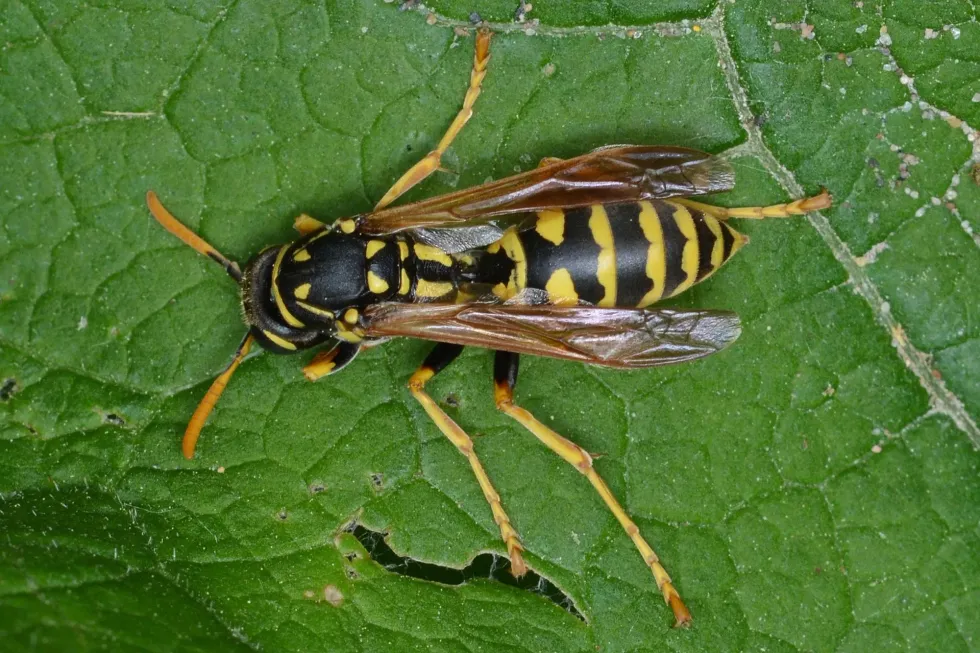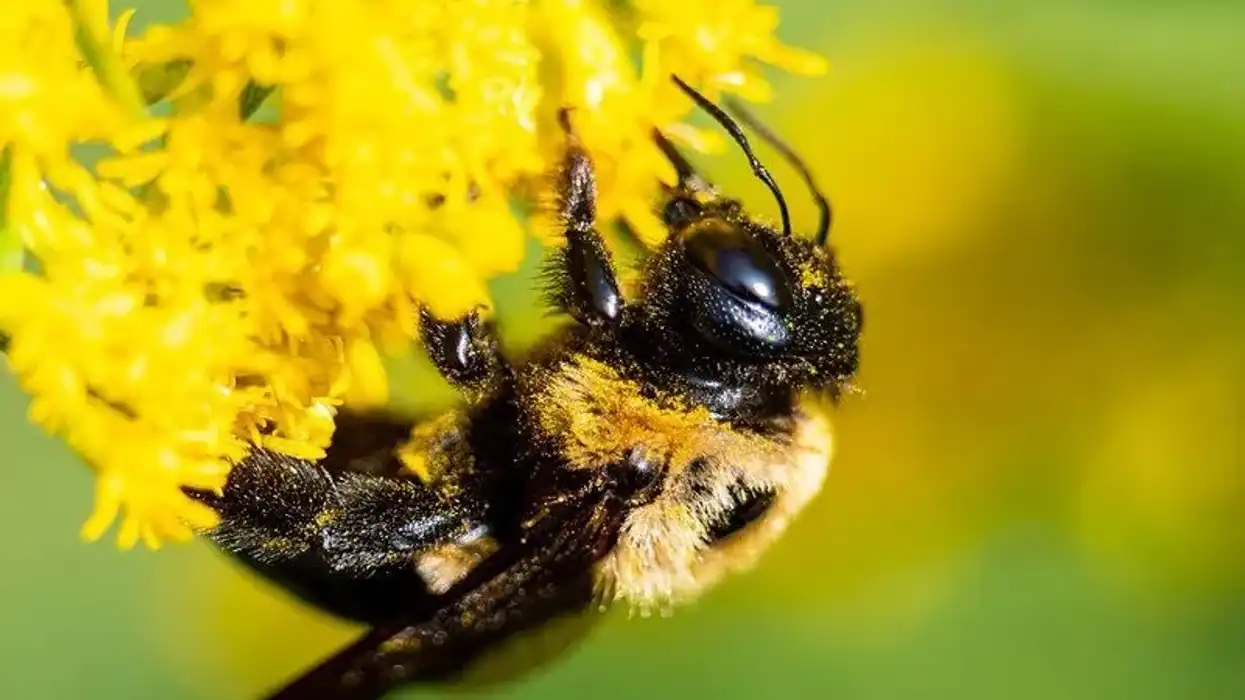European paper wasp (Polistes dominula) is the most common paper wasp found across all the continents, often more common than native species. Their native range includes southern Europe, northern Africa, and Asia.
These wasps were introduced to North America, South Africa, and Western Australia in the 1970s, '80s, and '90s. They belong to the family Vespidae of order Hymenoptera. They are also known by the two alternate names, Polistes gallicus, and Polistes dominulus.
They are diurnal and can be found in temperate and terrestrial habitats where they can feed and nest. They are omnivores and feed on a range of insects, honeydew, and nectar. This species has a black body with yellow markings that differ with respect to sex and hierarchy.
They are sexually dimorphic, with the females being larger than the males. They also have a black ventral surface as opposed to the yellow ventral surface in males.
These social wasps follow a hierarchy where the queen comes on top and the workers beneath. There exists a hierarchy even among the workers.
The queens, or reproductive females, can survive through the winter by hibernating. They contribute to pollination processes and control of pests. However, in places where they are sn invasive species, their population can be a threat to native species of wasps.
If you like this article, check out the braconid wasp and the potter wasp.
European Paper Wasp Interesting Facts
What type of animal is a European paper wasp?
The European paper wasp (Polistes dominula) is a type of insect.
What class of animals does a European paper wasp belong to?
European paper wasps belong to the class Insecta, which comprises a wide variety of insects. It comes under the family Vespidae of order Hymenoptera.
How many European paper wasps are there in the world?
Widespread across all the continents, Polistes dominula, is a very common species of paper wasps. However, an exact estimation of their population is not yet known.
Where does a European paper wasp live?
European paper wasp environment has a wide variety. They can be found in different types of temperate and terrestrial habitats.
They are native to the Mediterranian region, southern Europe, the Middle East, northern Africa, and China. After their introduction to North America in the 1970s, South Africa, and western Australia in the 1990s, these non-native species have spread rapidly and are more common than native species across the continents.
What is a European paper wasp's habitat?
Wasp Polistes dominulus live in paper nests made using wood fiber and paper. They can be found living in colonies in woodland, chaparrals, grasslands, urban and suburban areas. Their colony can also be found inhabiting human areas.
Who do European paper wasps live with?
They are social insects. These social wasps live in colonies of 12-100 wasps, with a queen like honeybees or ants. The colonies are founded, and nests are constructed by the females in spring, either alone or with the help of other females, all emerging from hibernation. They sometimes also wait for other foundresses to abandon their nest.
They then occupy that nest. Breeding in an old abandoned nest is not common. After winter, mostly, the nest is discarded.
How long does a European paper wasp live?
European paper wasp life span differs between queen and worker. European paper wasp queen lives longer than male wasps and non-reproductive female wasps. The queens can survive the winters by hibernating, whereas the workers cannot. European paper wasp worker has a lifespan of less than a year. Queens have been known to survive multiple seasons.
How do they reproduce?
The queen in a colony, generally, mates with multiple male wasps. They may or may not be nestmates.
They follow the lek mating system, where the aggregation of male wasps compete with each other to court the queen in the nest sites. The dominant male wasps are more often chosen for mating.
They reproduce through internal sexual reproduction. They breed throughout spring, summer, and fall, resulting in many broods a year.
They store sperm, and fertilization takes place in spring. The queens find nest sites and either build a nest alone or with help or sometimes even occupy an abandoned nest. There will be around 100 eggs per brood.
The eggs will be laid within the hexagonal cells and hatch in three to five days. The larvae are fed caterpillars after they are masticated.
The larvae undergo pupation inside their respective cells and develop into adults within three to four weeks. These adult wasps from the first brood of the season will be worker wasps subordinate to the queen, who will expand the nest by constructing more cells and find food for the coming broods.
What is their conservation status?
According to the IUCN, International Union for Conservation of Nature, the European paper wasps (Polistes dominula) come under the Not Listed status. They are common and widespread across all the continents. There is no immediate threat to their population, nor are they endangered.
European Paper Wasp Fun Facts
What do European paper wasps look like?

An average adult European paper wasp is 0.8 in (2 cm) long. These wasps have a black body with yellow rings and spots that vary with gender and dominance. The antennae are yellow in color.
They have a hard exoskeleton, a pair of antennae and wings, and six legs. They exhibit sexual dimorphism. A European paper wasp female has a forewing length of 0.37-0.51 in (9.5-13 mm), whereas that of a male is 0.33-0.47 in (8.5-12 mm).
The ventral surface in females is black in color, while it is yellow in male wasps. They have numerous ocelli, in addition to their compound eyes. This species of wasp, Polistes dominulus, has a black body with distinct yellow markings.
How cute are they?
Even though these paper wasps look pretty with their black and yellow structures, they are not exactly friendly or cute.
How do they communicate?
For communication, they use isolated cuticular hydrocarbons located on the epicuticle to act as chemical signals that help in the identification of their nestmates and non-nestmates. These hydrocarbons help in recognizing their nests are well.
They are aggressive insects and use tactile communication, namely in the form of mounting and boxing, to exert their dominance. The patterns on males and females also decide whether a wasp is dominant. By drumming on the developing larvae, their genes can be altered to make them either worker wasps or foundresses.
How big is a European paper wasp?
An average European paper wasp is around 0.8 in (2 cm) long. It is roughly 20 times bigger than a fairy wasp or fairyfly.
How fast can a European paper wasp fly?
The average flying speed of wasps is a few miles per hour. Even though European paper wasps are fast flyers, their exact flying speed is not available.
How much does a European paper wasp weigh?
An average European paper wasp weighs around 0.0026-0.0038 oz (74.4-108 mg).
What are their male and female names of the species?
There are no distinct names for males and females. A wasp of this species, whether male or female, is commonly known as a European paper wasp.
What would you call a baby European paper wasp?
The young ones can be called larvae or pupae in their respective stages of metamorphosis. There are no specific names for them.
What do they eat?
European paper wasps are omnivores. They generally prey on insects, mainly caterpillars. The developing larvae are fed with caterpillars. Adult paper wasps feed on nectar, honeydew, and aphids from flowers. They help control pests.
Are they poisonous?
These paper wasps defend themselves by stinging the intruder. Their stingers are curved with internal barbs.
They can repeatedly attack, unlike honeybees, as they can remove their stingers easily after stinging. The European paper wasp sting can cause swelling and allergic reactions. It is important to get it medically examined, especially if you are allergic to European paper wasp venom.
Would they make a good pet?
With its multiple attack ability, the European paper wasp stinger can really hurt, and it is better not to keep them as pets. The safer and more sensible option would be to coexist if found near your house peacefully.
They contribute to pest control and can be beneficial for your garden.
They will only attack if they feel threatened. If anyone in your house is allergic to wasps or if the nest is located where people frequent, then it is best to remove them using European paper wasp control methods, such as a European paper wasp trap.
Did you know...
Paper wasps are attracted to sweet fruit-based baits such as apple slices, crushed grapes, and sweet foods.
Most wasps in North America are invasive species and not native. Their population is a threat to the native population of Polistes fuscatus wasps. An increase in their number can alter the balance of native flora and fauna.
If the paper wasps become a nuisance, you should get rid of them. Before approaching the nest, make sure that you are wearing protective gears to shield yourself.
Carry out your plan during the night as these wasps are diurnal. You can use knockdown sprays and nest treatments to get rid of them. In case of stings, seek medical help immediately.
A queen European paper wasp is bigger than the other worker wasps.
What do European paper wasp nests look like?
A European paper wasp nest is made of wood fiber and a paper-like substance. These umbrella-shaped paper nests, which resemble open combs, can be seen hanging on human-made structures like chimneys, garages, beams, or on rocks. The nest construction starts in spring and is continued after the first brood of the season hatches.
The nest consists of numerous hexagonal-shaped openings. The nests are not enclosed. The eggs are laid in each of these cells in the nests.
How many species of paper wasps are there?
Wasps that come under the subfamily Polistinae are commonly known as paper wasps. There are about 1100 species and many more subspecies considered as paper wasps across the world.
Here at Kidadl, we have carefully created lots of interesting family-friendly animal facts for everyone to discover! Learn more about some other arthropods, including the red paper wasp and the mud dauber wasp.
You can even occupy yourself at home by drawing one of our European Paper Wasp coloring pages.










